Author
|
Message

|
 Breeding Journal, Species: Lysmata boggessi
Friday, November 4, 2011 9:39 PM
Breeding Journal, Species: Lysmata boggessi
Friday, November 4, 2011 9:39 PM
( permalink)
Breeding Journal DataSheet
This first post should be updated regularly to include new information as events take place or changes are made to your system General Species: Lysmata boggessi Social Structure: Currently, a pair Size of Individuals: About 2 1/2" Age of Individuals: At least 3 years Date added to Tank: June 2008 Broodstock Tank Details Size of Tank: 210 Gallons Substrate Details: Aragonite sand, live rock Filtration Details: Protein skimmer, RDSB, Chaetomorpha in sump, UV Water Changes: Infrequent and inadequate Water Temperature: Typically ranges from 78F to 82F Lighting: 4 x 39 watt Actinic T5 + 3 x 250 W MH Lighting Cycle: Actinics on appx. 12 hours per day (timer recently broke -- on manual now) MH on 10 AM to 4 PM each day. Other Tank Inhabitants: Many other fish and inverts. Broodstock Feeding Details Food Types: Mixed and varied frozen fish foods. Feeding Schedule: 2-3 times a day (sometimes 4 times a day) Spawning Details Date of First Spawn: Unknown Spawn Time of Day: Unknown. Dates of Consecutive Spawns: Unknown. Courtship Details: Not observed. Egg Size: Small Egg Color: Red Egg Count: Hundreds Hatch Details Hatch Date: 9/9/2011 Hatch Time of Day: Appx. 10 PM, shortly after lights out # Days after Spawn: Unknown Larvae Description: Hundreds of small, strongly phototactic larval shrimp. Larval Tank Details Temperature: Ambient room temp -- 72-74 F Size of Larval Tank: Initially, a 5.5 gallon tank filled with appx 2 gallons of water. Later, a 2 gallon fishbowl, completely full. Later still, a 5.5 gallon tank completely full. Substrate Details: None Other Tank Decor: None Filtration Details: Initially, just live phytoplankton + light. Later, a small HOB filter. Lighting: CFL or small fluorescent strip light. Lighting Cycle: Appx. 14 hours on / 10 hours off Water Changes: Small and frequent Larval Feeding Details Food Types: Mostly live copepods. Some rotifers in the first few days. Later, also some frozen cyclopeze too. Feeding Schedule: Initially, continuous. Later on, 2-3 times a day. Metamorphosis/Settlement Date of Settlement Start: 10/31/2011 Days after Hatch: 52 Date of Settlement End: 11/11/2011 Description of Fry: Small, reddish shrimp. Like very small versions of parents, but more translucent.
Grow-Out Tank Details Temperature: Size of Grow-Out Tank: Substrate Details: Other Tank Decor: Filtration Details: Lighting: Lighting Cycle: Water Changes: Size at Transfer: Age at Transfer: Grow-Out Feeding Details Food Types: Feeding Schedule: Additional Information (No Pictures or Videos in the Section Please) Miscellaneous Information: This report was first created to document my first metamorphosis/settlement event for this species. I did not "deliberately" culture these guys. They were "hitchhikers" or "volunteers" in one of my Bluestripe pipefish fry batches, and simply got caught in the larval snagger when I was snagging the pipes. I did nothing at all to deliberately culture these; I simply let them live and exist while I was raising the pipefish fry. Basically, I did nothing at all specifically to culture them aside from being aware that they were there, and causing them no deliberate harm. In other words, I simply have not deliberately killed them, and just let them be. You will be required to provide photographic evidence in this thread of each event submitted for the MBI Program.
If your thread does not contain these photos the MBI Committee will not be able to approve your reports.
<message edited by JimWelsh on Saturday, November 12, 2011 11:29 PM>
|
|
|
 Re:Breeding Journal, Species: Lysmata boggessi
Friday, November 4, 2011 9:58 PM
Re:Breeding Journal, Species: Lysmata boggessi
Friday, November 4, 2011 9:58 PM
( permalink)
I've been watching these Peppermint shrimp larvae co-exist in one of my pipefish cultures ever since they were both hatched on 9/9/2011. Fortunately, it seems that the techniques I use for culturing the pipes works well for the shrimp, too! Here's the story on them: On 9/9/2011, I had a pipefish fry hatch, and these guys hatched, too. Both types of larvae got caught in the snagger that night. I made no effort to separate them, and just attempted to raise the pipes, and simply ignored the shrimp. At first, I put them together in a 5.5 gallon tank with appx. 2 gallons of parent tank water. I fed them a few rotifers, and also a bunch of Apocyclops. The pipes didn't do so well this time; only 2 of them ultimately survived. After about 7-10 days, I transferred the two surviving pipes and a bunch of the surviving shrimp larvae into a 2 gallon fishbowl kriesel, where they lived for another 2 or 3 weeks. I then transferred them all into a 5.5 gallon tank, where they have all been growing together ever since, to the present day. About 8 of the shrimp larvae survived to live in the current 5.5 gallon tank. I've been watching them grow over time, getting more and more appendages, just like April Kirkendoll describes in her book. They have done very well in the 5.5 gallon tank, and I've seen a consistent count of 8 of them for the last several weeks, until this week. I noticed that suddenly, early this week, the count of the shrimp larvae has diminished dramatically. As of tonight, I can only see two shrimp larvae. My hope was that the others had settled, but there are some PVC pipes in the tank to make "caves" for the pipes, and there is also a bunch of detritus in the tank, and it's been impossible to find the settled shrimp, assuming they are there. So, tonight, I decided to take out all the PVC pipes, and see if I could locate any settled shrimp. Turns out, I have counted 4 of them! I'm assuming that the other two have also settled, but I just didn't see them. Remember that there are also something like 30 to 40 juvenile pipefish in this tank, too. Here are some pictures of the settled shrimp. The first pic is of the largest shrimp I could find, hanging out near the HOB filter. Sorry for the lousy pic. The second and third pics are of one smaller one I was able to catch with the turkey baster and place in a beaker for the photo op. 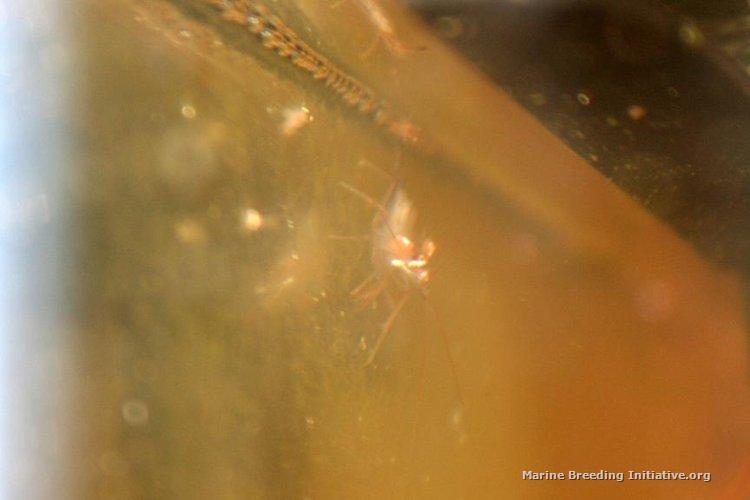 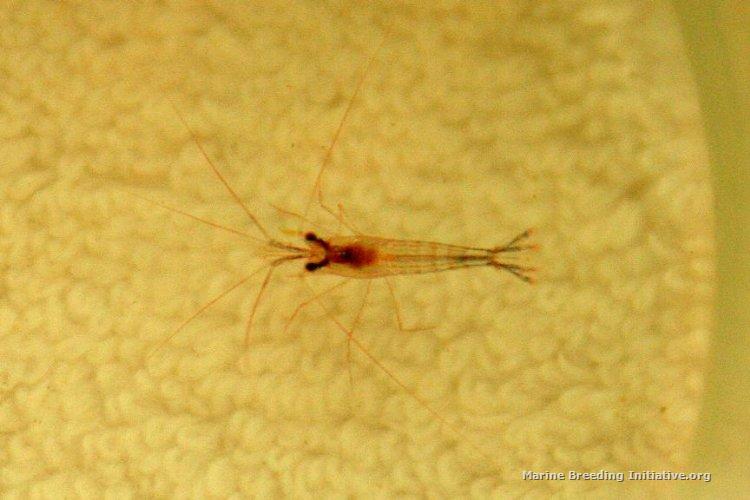 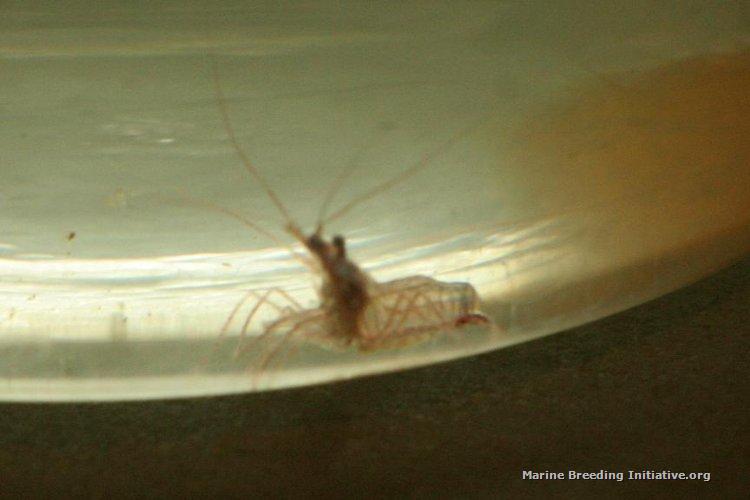 Hopefully, at least one of them will make it to 60DPS! I'll likely document the Spawn and Hatch events for this species from a different pair in a different tank, simply because it will be easier to do so than to try to document these events for the pair in the 210.
<message edited by JimWelsh on Wednesday, November 9, 2011 9:24 PM>
|
|
|
 Re:Breeding Journal, Species: Lysmata wurdemanni
Friday, November 4, 2011 11:59 PM
Re:Breeding Journal, Species: Lysmata wurdemanni
Friday, November 4, 2011 11:59 PM
( permalink)
very cute!
|
|
|
 Re:Breeding Journal, Species: Lysmata wurdemanni
Saturday, November 5, 2011 11:14 AM
Re:Breeding Journal, Species: Lysmata wurdemanni
Saturday, November 5, 2011 11:14 AM
( permalink)
Oh, they settled for you! You culture them inadvertently and I can't culture them for the life of me! 
|
|
|
 Re:Breeding Journal, Species: Lysmata boggessi
Wednesday, November 9, 2011 9:30 PM
Re:Breeding Journal, Species: Lysmata boggessi
Wednesday, November 9, 2011 9:30 PM
( permalink)
I think I have determined that my species is L. boggessi, rather than L. wurdemanni, so I've changed the subject and species in the first post accordingly. Now that they've settled, these guys are really growing very quickly! They are mostly hanging out near some black ABS pipes I have in the pipefish tank for the pipefish to use as "caves" (no pun intended). The area around these ABS pipes is very clean, as opposed to the rest of the floor of the tank, which has quite an accumulation of detritus. They are really keeping their immediate vicinity quite clean.
|
|
|
 Re:Breeding Journal, Species: Lysmata boggessi
Saturday, November 26, 2011 9:25 PM
Re:Breeding Journal, Species: Lysmata boggessi
Saturday, November 26, 2011 9:25 PM
( permalink)
I have seen some of the pipefish snicking at the bellies of the peppermint shrimp when the pipes are really hungry lately, so I decided to move them to the 65 gallon tank that I've recently put back into production. As an aside, this is the same tank that I wanted to kill all the Aiptasia and Bubble Algae in a couple of months ago, and so I did an extreme bleach treatment on it and the live rock and live sand in it. I've been cycling it with the ammonia method for quite a while, and have recently put two Neon Gobies, a pair of Red Scooter Blennies, and some seahorses in it. Guess what I saw just the other day? Yes, that's right -- several tiny Aiptasia!!! Hopefully these guys will help keep them at bay. There are 9 of them, and not 8 like I thought. Some of them are growing really quickly -- the largest is about 1 1/2" long now, and they only started settling less than 4 weeks ago. Here are some lousy pictures of that one. They are rather poor pictures, but good enough to verify that they are L. boggessi, I think: 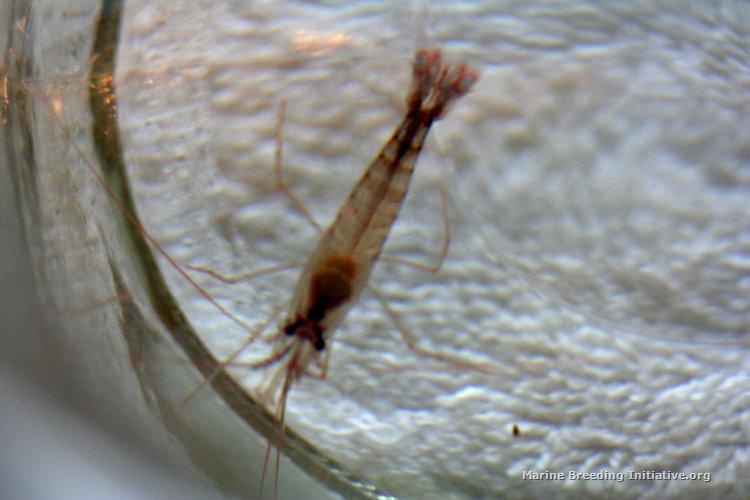 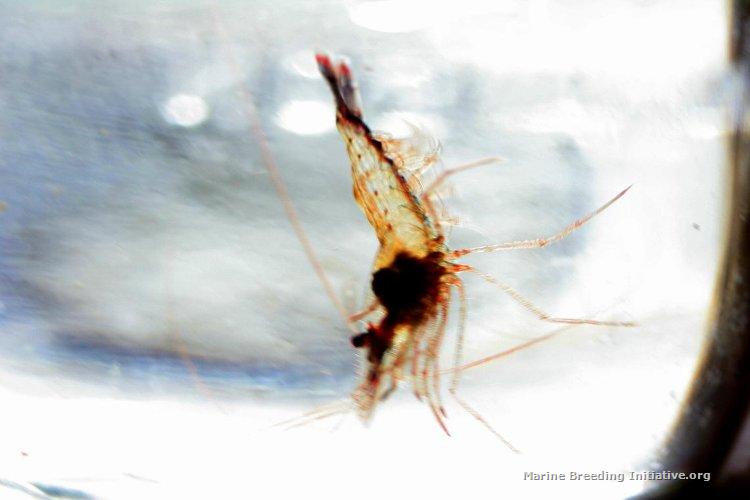 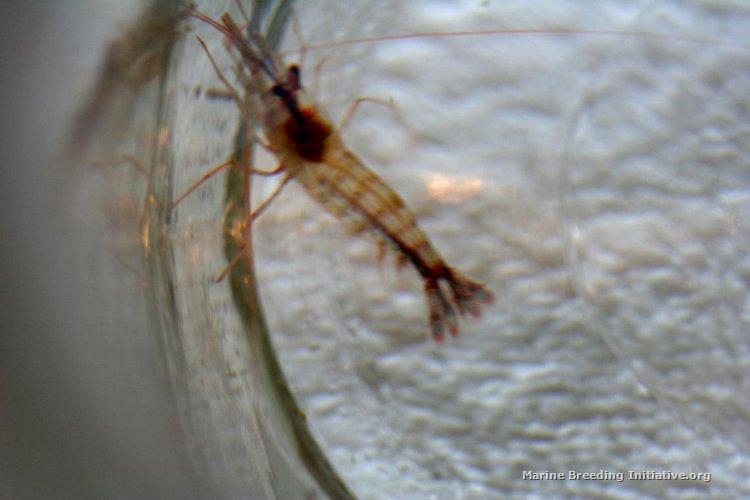
|
|
|
|